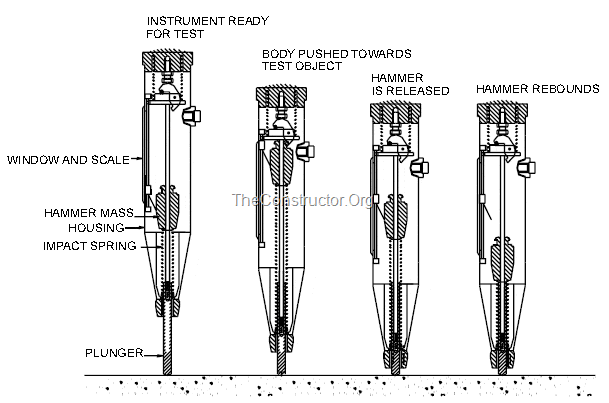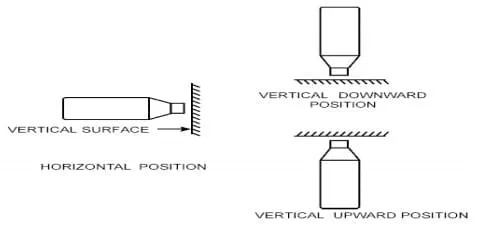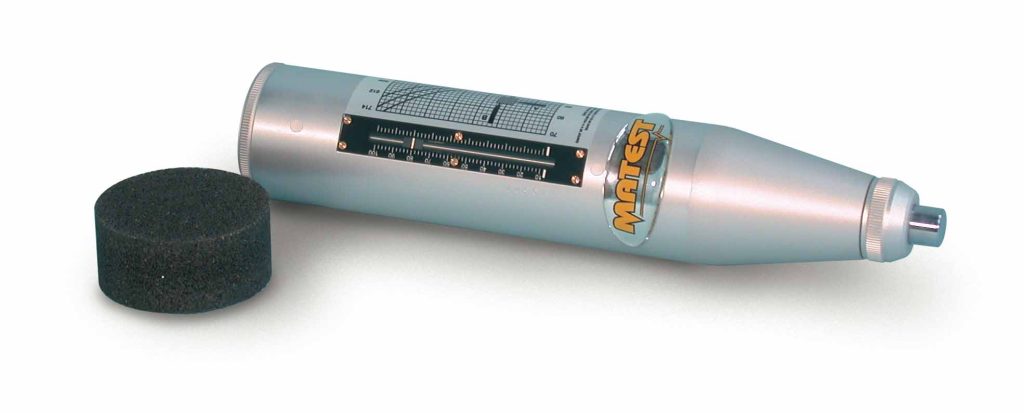Rebound Hammer test is a Non-destructive testing method of concrete which provide a convenient and rapid indication of the compressive strength of the concrete. The rebound hammer is also called as Schmidt hammer that consist of a spring controlled mass that slides on a plunger within a tubular housing. The operation of rebound hammer is shown in the fig.1. When the plunger of rebound hammer is pressed against the surface of concrete, a spring controlled mass with a constant energy is made to hit concrete surface to rebound back. The extent of rebound, which is a measure of surface hardness, is measured on a graduated scale. This measured value is designated as Rebound Number (rebound index). A concrete with low strength and low stiffness will absorb more energy to yield in a lower rebound value.

Fig.1.Operation of the rebound hammer
Objective of Rebound Hammer Test
As per the Indian code IS: 13311(2)-1992, the rebound hammer test have the following objectives:
- To determine the compressive strength of the concrete by relating the rebound index and the compressive strength
- To assess the uniformity of the concrete
- To assess the quality of the concrete based on the standard specifications
- To relate one concrete element with other in terms of quality
Rebound hammer test method can be used to differentiate the acceptable and questionable parts of the structure or to compare two different structures based on strength.
Principle of Rebound Hammer Test
Rebound hammer test method is based on the principle that the rebound of an elastic mass depends on the hardness of the concrete surface against which the mass strikes. The operation of the rebound hammer is shown in figure-1. When the plunger of rebound hammer is pressed against the concrete surface, the spring controlled mass in the hammer rebounds. The amount of rebound of the mass depends on the hardness of concrete surface. Thus, the hardness of concrete and rebound hammer reading can be correlated with compressive strength of concrete. The rebound value is read off along a graduated scale and is designated as the rebound number or rebound index. The compressive strength can be read directly from the graph provided on the body of the hammer.
Procedure for Rebound Hammer Test
Procedure for rebound hammer test on concrete structure starts with calibration of the rebound hammer. For this, the rebound hammer is tested against the test anvil made of steel having Brinell hardness number of about 5000 N/mm2. After the rebound hammer is tested for accuracy on the test anvil, the rebound hammer is held at right angles to the surface of the concrete structure for taking the readings. The test thus can be conducted horizontally on vertical surface and vertically upwards or downwards on horizontal surfaces as shown in figure below If the rebound hammer is held at intermediate angle, the rebound number will be different for the same concrete.


Fig.2.Rebound Hammer Positions for Testing Concrete Structure
The impact energy required for the rebound hammer is different for different applications. Approximate Impact energy levels are mentioned in the table-1 below for different applications.
Table-1: Impact Energy for Rebound Hammers for Different Applications As per IS: 13311(2)-1992
Sl.No | Applications | Approximate Impact Energy for Rebound Hammer in Nm |
1 | For Normal Weight Concrete | 2.25 |
2 | For light weight concrete / For small and impact resistive concrete parts | 0.75 |
3 | For mass concrete testing Eg: In roads, hydraulic structures and pavements | 30.00 |
Points to Remember in Rebound Hammer Test
- The concrete surface should be smooth, clean and dry.
- Ant loose particles should be rubbed off from the concrete surface with a grinding wheel or stone, before hammer testing.
- Rebound hammer test should not be conducted on rough surfaces as a result of incomplete compaction, loss of grout, spalled or tooled concrete surface.
- The point of impact of rebound hammer on concrete surface should be at least 20mm away from edge or shape discontinuity.
- Six readings of rebound number is taken at each point of testing and an average of value of the readings is taken as rebound index for the corresponding point of observation on concrete surface.
Correlation between compressive strength of concrete and rebound number
The most suitable method of obtaining the correlation between compressive strength of concrete and rebound number is to test the concrete cubes using compression testing machine as well as using rebound hammer simultaneously. First the rebound number of concrete cube is taken and then the compressive strength is tested on compression testing machine. The fixed load required is of the order of 7 N/ mm2 when the impact energy of the hammer is about 2.2 Nm. The load should be increased for calibrating rebound hammers of greater impact energy and decreased for calibrating rebound hammers of lesser impact energy. The test specimens should be as large a mass as possible in order to minimize the size effect on the test result of a full scale structure. 150mm cube specimens are preferred for calibrating rebound hammers of lower impact energy (2.2Nm), whereas for rebound hammers of higher impact energy, for example 30 Nm, the test cubes should not be smaller than 300mm. The concrete cube specimens should be kept at room temperature for about 24 hours after taking it out from the curing pond, before testing it with the rebound hammer. To obtain a correlation between rebound numbers and strength of wet cured and wet tested cubes, it is necessary to establish a correlation between the strength of wet tested cubes and the strength of dry tested cubes on which rebound readings are taken. A direct correlation between rebound numbers on wet cubes and the strength of wet cubes is not recommended. Only the vertical faces of the cubes as cast should be tested. At least nine readings should be taken on each of the two vertical faces accessible in the compression testing machine when using the rebound hammers. The points of impact on the specimen must not be nearer an edge than 20mm and should be not less than 20mm from each other. The same points must not be impacted more than once.
Interpretation of Rebound Hammer Test Results
After obtaining the correlation between compressive strength and rebound number, the strength of structure can be assessed. In general, the rebound number increases as the strength increases and is also affected by a number of parameters i.e. type of cement, type of aggregate, surface condition and moisture content of the concrete, curing and age of concrete, carbonation of concrete surface etc.

Fig.3.Relationship Between Cube Strength and the Rebound Number
Moreover the rebound index is indicative of compressive strength of concrete up to a limited depth from the surface. The internal cracks, flaws etc. or heterogeneity across the cross section will not be indicated by rebound numbers. Table-2 below shows the quality of concrete for respective average rebound number.
Table.2. Quality of Concrete for different values of rebound number

As such the estimation of strength of concrete by rebound hammer method cannot be held to be very accurate and probable accuracy of prediction of concrete strength in a structure is ± 25 percent. If the relationship between rebound index and compressive strength can be found by tests on core samples obtained from the structure or standard specimens made with the same concrete materials and mix proportion, then the accuracy of results and confidence thereon gets greatly increased.
The advantages of Rebound hammer tests are:
- Apparatus is easy to use
- Determines uniformity properties of the surface
- The equipment used is inexpensive
- Used for the rehabilitation of old monuments
The disadvantages of Rebound Hammer Test
- The results obtained is based on a local point
- The test results are not directly related to the strength and the deformation property of the surface
- The probe and spring arrangement will require regular cleaning and maintenance
- Flaws cannot be detected with accuracy
Factors Influencing Rebound Hammer Test
Below mentioned are the important factors that influence rebound hammer test:
- Type of Aggregate
- Type of Cement
- Surface and moisture condition of the concrete
- Curing and Age of concrete
- Carbonation of concrete surface
Type of Aggregate
The correlation between compressive strength of concrete and the rebound number will vary with the use of different aggregates. Normal correlations in the results are obtained by the use of normal aggregates like gravels and crushed aggregates. The use of lightweight aggregates in concrete will require special calibration to undergo the test.
Type of Cement
The concrete made of high alumina cement ought to have higher compressive strength compared to Ordinary portland cement. The use of supersulphated cement in concrete decrease the compressive strength by 50% compared to that of OPC.
Type of Surface and Moisture Condition
The rebound hammer test work best for close texture concrete compared with open texture concrete. Concrete with high honeycombs and no-fines concrete is not suitable to be tested by rebound hammer. The strength is overestimated by the test when testing floated or trowelled surfaces when compared with moulded surfaces. Wet concrete surface if tested will give a lower strength value. This underestimation of strength can go lower to 20% that of dry concrete.
Type of curing and age of concrete
As time passes, the relation between the strength and hardness of concrete will change. Curing conditions of concrete and their moisture exposure conditions also affects this relationship. For concrete with an age between 3days to 90 days is exempted from the effect of age. For greater aged concrete special calibrated curves is necessary.

